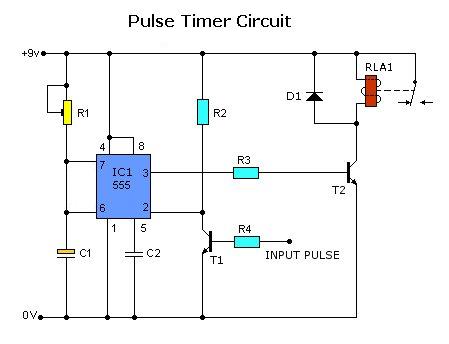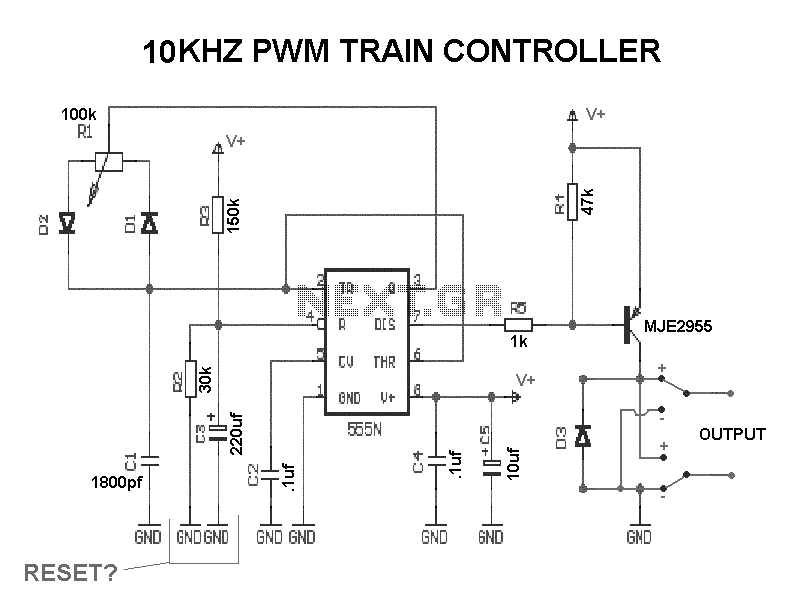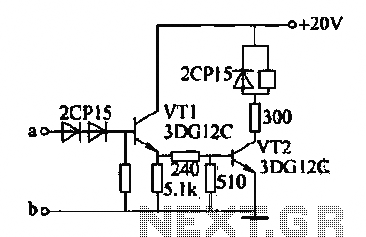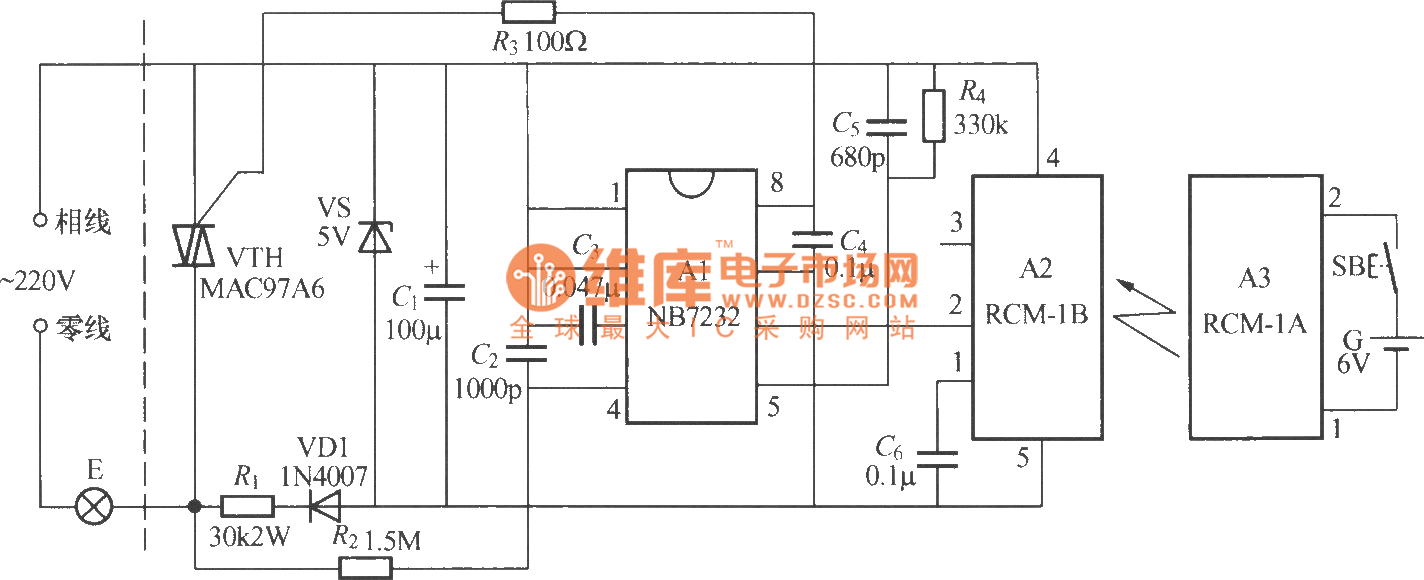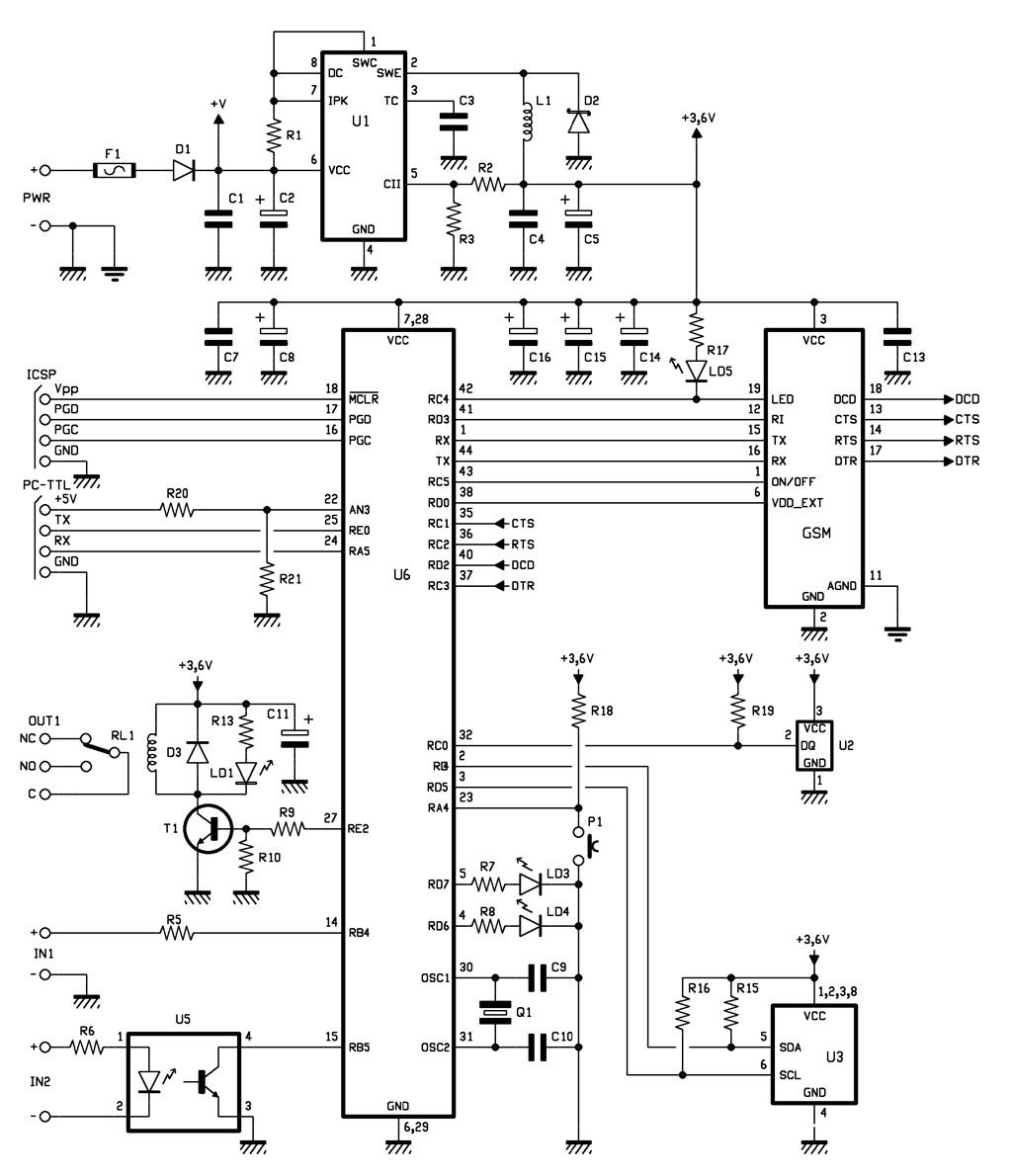
ir remote control home appliances
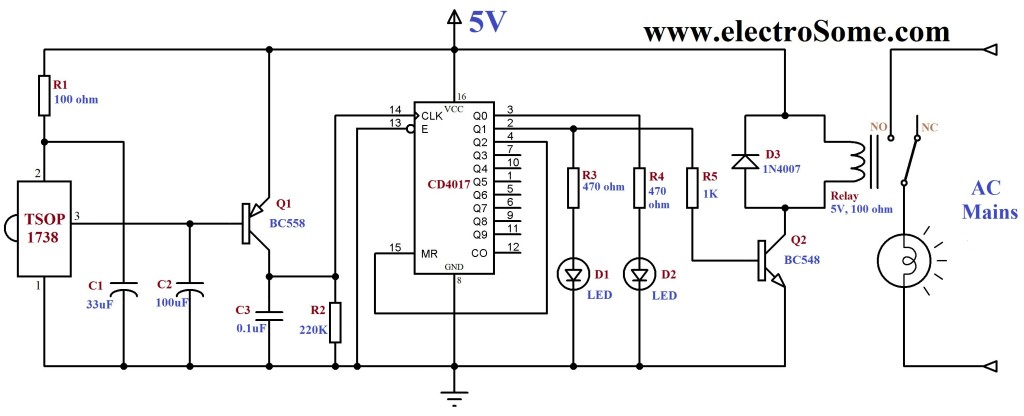
An infrared (IR) remote control circuit for managing home appliances can be constructed using a Decade Counter CD4017, a 555 Timer, and a TSOP1738 infrared receiver. This circuit allows users to control home devices with a standard remote control, such as those for TVs or DVD players. The second and first pins of the TSOP1738 are connected to supply power, with Vcc and Gnd respectively. A 100Ω resistor and a 33μF capacitor are included to suppress power supply disturbances. When infrared signals at 38KHz are received by the TSOP1738, the output at the third pin goes low, as it operates in an active-low configuration. This low output is then amplified by transistor Q1 and sent to the clock input of the CD4017. The 16th and 8th pins of the CD4017 are used to supply power (Vcc) and ground (Gnd) respectively. The enable pin (13th pin) is connected to ground to activate the IC, since it is an active-low input. Output Q2 (4th pin) is linked to the reset (MR) pin (15th pin) to configure the CD4017 as a bistable multivibrator. Upon receiving the first clock signal, Q0 goes high; the second clock signal causes Q1 to go high (while Q0 goes low), and the third clock signal makes Q0 high again (due to Q2 being connected to MR, the third clock resets the counter). Assuming the counter starts in a reset state (Q0 high and all others low), pressing the remote generates a clock signal that turns Q1 high, causing LED D1 to illuminate. This action activates transistor Q2, which in turn energizes the relay. A subsequent press of the remote results in Q0 going high, illuminating LED D2. LED D1 indicates that the appliance is powered on, while LED D2 indicates it is powered off. The TSOP1738 is designed to detect signals with a carrier frequency around 38KHz. This functionality is achieved through an astable multivibrator configuration using the 555 timer.
The proposed infrared remote control circuit is a versatile solution for home automation, leveraging the capabilities of the CD4017 decade counter to manage multiple outputs based on the received IR signals. The TSOP1738 infrared receiver is specifically selected for its sensitivity to the 38KHz carrier frequency, which is standard for consumer remote controls, ensuring compatibility with a wide range of devices.
The inclusion of the 555 Timer configured as an astable multivibrator provides a reliable clock signal that drives the CD4017. The timer's frequency can be adjusted to optimize the response time of the circuit, allowing for quick and efficient control of home appliances. The use of transistors for signal amplification ensures that the output from the TSOP1738 can effectively drive the clock input of the CD4017, maintaining signal integrity and responsiveness.
The circuit's design also incorporates visual indicators through the use of LEDs, which provide immediate feedback regarding the status of the appliances being controlled. This feature enhances user interaction and allows for easy monitoring of the system's operation. The relay interface is crucial for controlling high-power devices, ensuring that the low-power signals from the logic components can safely operate larger loads.
Overall, this IR remote control circuit exemplifies a practical application of basic electronic components to create an effective home automation solution, enabling convenient control of various appliances from a distance. The design can be further enhanced by integrating additional features such as programmable settings or multiple device control, depending on user requirements.An IR Remote Control for controlling home appliances can be easily made using Decade Counter CD4017, 555 Timer and TSOP1738 infrared receiver. By using this circuit you can easily control your home appliances using your TV, DVD Player remote control or using a remote control circuit described here.
2nd and 1st pins of TSOP1738 are used to give power, Vcc and Gnd respectively. 100G © resistor and 33G F capacitor is to suppress power supply disturbances. When IR rays at 38KHz falls on TSOP1738, output (3ed pin) goes low, since the output is active low. This output is amplified by the transistor Q1 and is given to the clock input of CD4017. 16th and 8th pins of CD4017 is used to give power Vcc and Gnd respectively. Enable (13th pin) is tied to Gnd to enable the IC, since it is an active low input. Output Q2 (4th pin) is connected to Reset MR (15th pin) to make CD4017 a bistable multivibrator. During the first clock signal Q0 becomes high, second clock signal makes Q1 high (Q0 becomes low) and the third clock signal makes Q0 high (since Q2 is connected to MR, third clock signal resets the counter). Lets assume the counter is Reset state (Q0 high and others low). When the remote is pressed, clock signal is generated which makes Q1 is high. Thus LED D1 glows, transistor Q2 turns ON and which energizes the relay. When the remote is pressed again, Q0 becomes high LED D2 glows. LED D1 indicates when the appliance is ON and LED D2 indicates when the appliance is OFF. TSOP1738 detects only those signals whose carrier frequency is around 38KHz. Thus it is accomplished using Astable Multivibrator using 555 timer. Please read this article for more details about above circuit. 🔗 External reference
The proposed infrared remote control circuit is a versatile solution for home automation, leveraging the capabilities of the CD4017 decade counter to manage multiple outputs based on the received IR signals. The TSOP1738 infrared receiver is specifically selected for its sensitivity to the 38KHz carrier frequency, which is standard for consumer remote controls, ensuring compatibility with a wide range of devices.
The inclusion of the 555 Timer configured as an astable multivibrator provides a reliable clock signal that drives the CD4017. The timer's frequency can be adjusted to optimize the response time of the circuit, allowing for quick and efficient control of home appliances. The use of transistors for signal amplification ensures that the output from the TSOP1738 can effectively drive the clock input of the CD4017, maintaining signal integrity and responsiveness.
The circuit's design also incorporates visual indicators through the use of LEDs, which provide immediate feedback regarding the status of the appliances being controlled. This feature enhances user interaction and allows for easy monitoring of the system's operation. The relay interface is crucial for controlling high-power devices, ensuring that the low-power signals from the logic components can safely operate larger loads.
Overall, this IR remote control circuit exemplifies a practical application of basic electronic components to create an effective home automation solution, enabling convenient control of various appliances from a distance. The design can be further enhanced by integrating additional features such as programmable settings or multiple device control, depending on user requirements.An IR Remote Control for controlling home appliances can be easily made using Decade Counter CD4017, 555 Timer and TSOP1738 infrared receiver. By using this circuit you can easily control your home appliances using your TV, DVD Player remote control or using a remote control circuit described here.
2nd and 1st pins of TSOP1738 are used to give power, Vcc and Gnd respectively. 100G © resistor and 33G F capacitor is to suppress power supply disturbances. When IR rays at 38KHz falls on TSOP1738, output (3ed pin) goes low, since the output is active low. This output is amplified by the transistor Q1 and is given to the clock input of CD4017. 16th and 8th pins of CD4017 is used to give power Vcc and Gnd respectively. Enable (13th pin) is tied to Gnd to enable the IC, since it is an active low input. Output Q2 (4th pin) is connected to Reset MR (15th pin) to make CD4017 a bistable multivibrator. During the first clock signal Q0 becomes high, second clock signal makes Q1 high (Q0 becomes low) and the third clock signal makes Q0 high (since Q2 is connected to MR, third clock signal resets the counter). Lets assume the counter is Reset state (Q0 high and others low). When the remote is pressed, clock signal is generated which makes Q1 is high. Thus LED D1 glows, transistor Q2 turns ON and which energizes the relay. When the remote is pressed again, Q0 becomes high LED D2 glows. LED D1 indicates when the appliance is ON and LED D2 indicates when the appliance is OFF. TSOP1738 detects only those signals whose carrier frequency is around 38KHz. Thus it is accomplished using Astable Multivibrator using 555 timer. Please read this article for more details about above circuit. 🔗 External reference
